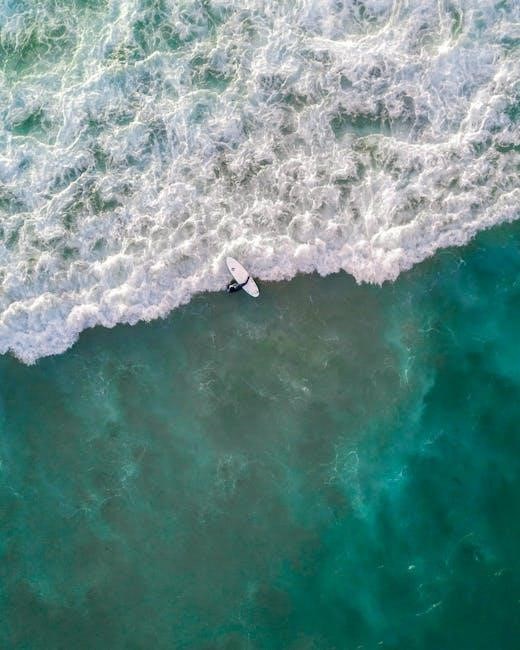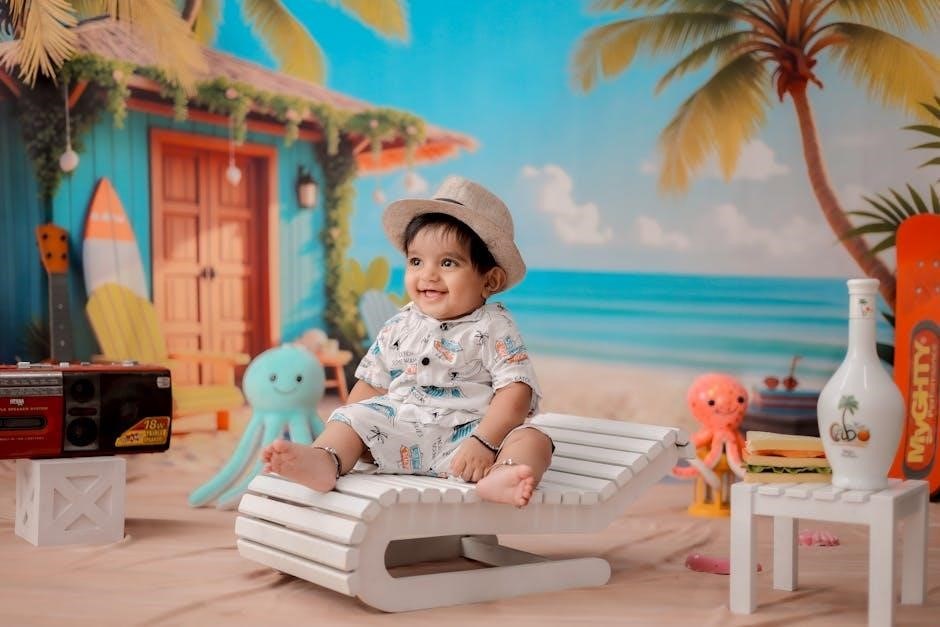Selecting the right surfboard is crucial for improving your surfing experience. Consider factors like skill level, body type, and surfing goals to ensure the best fit. Size, volume, and material play significant roles in performance, so choose wisely to enhance your time in the water.
Overview of Surfboard Types

Surfboards come in various shapes, sizes, and designs, catering to different skill levels, wave conditions, and surfing styles. The most common types include shortboards, known for their maneuverability and performance in advanced surfing, and longboards, which offer stability and ease for cruising and carving. Funboards provide a hybrid shape, combining elements of both for versatility, while soft-top surfboards, often called foamies, are ideal for beginners due to their soft, durable construction. Other types include fish boards, designed for speed in small waves, and SUP (Stand-Up Paddleboard) boards, which are larger and used for both surfing and paddling. Each type has unique characteristics, making it important to match the board to your surfing goals and abilities for the best experience in the water.
Key Factors to Consider When Buying a Surfboard
When purchasing a surfboard, several key factors must be considered to ensure the right fit for your needs. First, assess your skill level—beginners may benefit from larger, more buoyant boards, while advanced surfers might prefer smaller, more maneuverable options. Body type and weight also play a role, as they influence the ideal volume and size of the board. Wave conditions and your surfing goals, whether recreational or performance-oriented, should guide your choice. Additionally, consider the board’s shape, material, and fin configuration, as these impact performance and durability. Lastly, don’t overlook practical aspects like leash compatibility and aesthetics. By carefully evaluating these elements, you can select a surfboard that enhances your surfing experience and helps you progress in the water.

Understanding Your Surfing Needs
Evaluate your skill level, body type, and surfing goals to determine the ideal board. Consider wave conditions, personal preferences, and how they align with your progression in surfing.
Assessing Your Skill Level: Beginner, Intermediate, or Advanced
Your skill level is a critical factor in choosing the right surfboard. Beginners benefit from larger, softer boards like soft-top surfboards, which are stable and forgiving, making it easier to catch waves and stay balanced. These boards are ideal for learning basic surfing skills and building confidence in the water. Intermediate surfers can transition to smaller, more maneuverable boards, such as funboards or soft-top shortboards, which offer a balance between stability and performance. Advanced surfers often prefer high-performance shortboards or specialized designs, allowing for sharper turns and speed in more challenging wave conditions. Be honest about your ability to ensure you select a board that matches your skills and helps you progress. Consulting with a knowledgeable surf shop expert can also provide valuable insights tailored to your needs.

Matching Your Body Type to the Right Surfboard
Your body type plays a significant role in selecting the right surfboard. Surfers with a larger build or more weight typically benefit from boards with higher volume, which provide greater buoyancy and stability. These boards, such as longboards or funboards, make it easier to catch waves and stay balanced. On the other hand, lighter or smaller surfers may find lower-volume boards, like shortboards, more maneuverable and suitable for their needs. Consider your height and weight when calculating your ideal board volume, as this ensures optimal performance and comfort in the water. A well-matched surfboard will enhance your ability to paddle, pop up, and control the board, making your surfing experience more enjoyable and effective. Always prioritize a board that aligns with your physical attributes for the best results.
Setting Your Surfing Goals: Recreation, Performance, or All-Around
Defining your surfing goals is essential to choosing the right surfboard. If your focus is recreation, prioritize a board that offers stability and ease of use, such as a soft-top or funboard, ensuring a fun and stress-free experience. For performance-oriented surfing, opt for a shortboard that delivers speed and maneuverability, ideal for advanced riders seeking thrill and precision. If you prefer an all-around approach, a hybrid shape like a funboard or mid-length board provides versatility, adapting to various wave conditions and surfing styles. Clearly identifying your goals helps narrow down the ideal board, ensuring it aligns with your aspirations and enhances your time in the water. Whether cruising casually or chasing adrenaline, the right surfboard will elevate your surfing journey.

Types of Surfboards
Surfboards come in various styles. Shortboards offer maneuverability, longboards provide stability, funboards and soft-tops are great for beginners, while fish, gun, and SUP boards cater to specific wave conditions.
Shortboards: Design, Features, and Performance
Shortboards are high-performance surfboards designed for intermediate to advanced surfers. Typically ranging from 5’8″ to 7′ in length, they are lightweight and maneuverable. Their streamlined design, featuring rounded noses and sharp rails, allows for quick turns and tight control in various wave conditions. Shortboards often have a squash or round tail, enhancing responsiveness. Made from materials like fiberglass or epoxy, they balance durability and weight. These boards excel in hollow waves and are ideal for surfers seeking speed and agility. However, their smaller size makes them less stable, making them challenging for beginners. Shortboards are a favorite among experienced riders who prioritize performance and precision in their surfing. They are versatile enough to handle different wave types, from beach breaks to reef waves, making them a popular choice for surfers worldwide.
Longboards: Classic Style and Cruising
Longboards are a timeless choice for surfers, offering a classic style and smooth cruising experience. Ranging from 8′ to 14′ in length, these boards are ideal for beginners and experienced riders alike. Their extended length provides stability and ease of catching waves, making them perfect for learning or enjoying relaxed rides. Longboards typically feature a rounded nose and square or rounded tail, enhancing buoyancy and maneuverability. They excel in smaller waves but can also perform well in larger conditions. Constructed from durable materials like fiberglass or wood, longboards are both functional and aesthetically appealing. Their laid-back style makes them a favorite for cruising and carving, offering a nostalgic connection to the roots of surfing. Whether you’re looking to improve your skills or simply enjoy a leisurely ride, longboards deliver a unique and rewarding experience.
Funboards: Hybrid Shapes for Versatility
Funboards are hybrid surfboards designed to offer versatility for surfers of all levels. Typically ranging from 7′ to 8.5′ in length, these boards combine elements of longboards and shortboards, making them ideal for both cruising and maneuverability. Their rounded noses and squared or rounded tails provide stability and ease of turning, while their moderate volume ensures buoyancy and wave-catching ability. Funboards are perfect for intermediate surfers looking to transition from soft-tops or for advanced riders seeking a fun, all-around board. They perform well in a variety of wave conditions, from small waves to medium-sized surf, and are often constructed from durable materials like epoxy or fiberglass. With their balanced design, funboards are a great choice for anyone looking to enjoy a versatile surfing experience.
Soft-Top Surfboards: Foamies for Beginners
Soft-top surfboards, often called “foamies,” are ideal for beginners due to their soft, foam construction, which reduces the risk of injury. These boards are durable, lightweight, and easy to handle, making them perfect for learning the basics of surfing. They typically range from 7′ to 9′ in length and have a rounded nose and soft fins, providing stability and forgiveness for new surfers. Soft-tops are excellent for catching waves and improving balance. Their buoyancy and ease of use make them a great starting point for those transitioning from boogie boards or entering the sport for the first time. Additionally, their affordability and durability make them a popular choice for surf schools and casual surfers alike.
Other Surfboard Types: Fish, Gun, and SUP Boards
Fish surfboards are known for their wide, rounded noses and swallow tails, offering exceptional speed and maneuverability in small to medium waves. These boards are ideal for intermediate to advanced surfers seeking playful performance. Gun surfboards, designed for big wave surfing, are longer and narrower with a pointed nose, providing stability and control in powerful conditions. SUP (Stand-Up Paddle) boards are larger, highly buoyant, and versatile, suitable for both calm waters and surfing. They are great for beginners or those seeking a relaxing experience. Each type caters to specific needs, whether it’s high-speed performance, big wave conquests, or casual cruising.

Key Considerations for Choosing a Surfboard
Key factors include size, volume, shape, materials, fins, and leash. These elements affect performance, stability, and durability, ensuring the board suits your needs.
Surfboard Size: Length, Width, and Thickness
Surfboard size, including length, width, and thickness, significantly impacts performance and ease of use. Longer boards (7–14 ft) offer stability and are ideal for beginners or cruising, while shorter boards (5–7 ft) provide maneuverability for advanced surfers. Width affects buoyancy and balance; wider boards (20–24 in) are easier to stand on, whereas narrower ones (18–20 in) enhance speed. Thickness influences floatation, with thicker boards (2.5–3.5 in) aiding beginners and thinner ones (2–2.5 in) offering better control for skilled riders. Balancing these dimensions ensures the board matches your skill level, wave preferences, and body type, optimizing your surfing experience.
Volume: How to Calculate Your Ideal Surfboard Volume
Surfboard volume, measured in liters, determines buoyancy and performance. A higher volume board floats better, making it easier to catch waves, while a lower volume board offers more control. To find your ideal volume, consider your weight, skill level, and surfing style. Use an online volume calculator or consult a formula that factors in your body weight and ability: beginner (higher volume), intermediate (moderate), or advanced (lower volume). Typically, a beginner might aim for 40–60 liters, intermediates 30–50 liters, and advanced riders 20–40 liters. Balancing volume with size ensures stability and maneuverability, optimizing your surfing experience based on your needs and progression.
Shape: Nose, Tail, and Rail Design
The shape of a surfboard, including the nose, tail, and rail design, plays a crucial role in its performance. The nose shape affects how the board enters the water, with rounded noses offering stability and pointed noses enhancing speed. The tail shape influences maneuverability and control, with options like squash, round, and swallow tails catering to different surfing styles. Rails, the edges of the board, determine how it interacts with the water. Hard rails provide speed and hold, while soft rails offer forgiveness and are ideal for beginners. Each design element works together to create a board that suits your surfing ability and wave preferences, ensuring optimal performance and control in the water.
Materials: Fiberglass, Epoxy, and Soft-Top Construction
Surfboards are crafted from various materials, each offering unique performance and durability. Fiberglass boards are the most traditional, known for their responsiveness and lightweight feel, making them ideal for advanced surfers. Epoxy boards are more durable and buoyant, often preferred for beginners or those surfing in rough conditions. Soft-top surfboards, made from foam, are highly durable and soft to the touch, making them perfect for learning and reducing the risk of injury. Each material caters to different needs, whether it’s performance, durability, or safety. Understanding these options helps you choose a board that aligns with your skill level and surfing environment, ensuring a better experience in the water.
Fins: Types, Configurations, and Their Impact on Performance
Fins are a critical component of a surfboard, directly influencing its performance in the water. The most common types include single fins, thrusters (three fins), and quads (four fins), each offering distinct characteristics. Single fins provide stability and control, ideal for cruising and classic longboard styles. Thrusters enhance maneuverability and speed, making them popular for shortboards. Quad fins deliver exceptional hold and drive, particularly in powerful waves. Fin size, shape, and material also play a role; larger fins offer more stability, while smaller ones allow for tighter turns. The configuration and design of fins can significantly impact how the board responds to your movements, making them a key consideration when selecting or customizing your surfboard to suit your surfing style and preferences.
Leash and Plug: Importance and Installation
A leash is an essential accessory for any surfboard, keeping it attached to your ankle and preventing it from being lost or damaged in the water. The leash plug, typically installed on the tail of the board, is a small fixture that secures the leash. Proper installation is crucial to ensure durability and safety. Most surfboards come with a pre-installed leash plug, but if not, it can be added by drilling a hole and inserting the plug, then screwing it into place. A high-quality leash with a sturdy cuff and flexible cord is recommended for reliability. Always check the plug for damage and ensure it’s tightly secured to avoid losing your board. A well-installed leash and plug system enhances both safety and performance, giving you peace of mind while surfing.
Color and Aesthetics: Choosing the Right Look
While color and aesthetics don’t affect performance, they can reflect your personal style. Surfboards come in a wide range of colors and designs, from bold solids to intricate patterns. Many surfers enjoy expressing their individuality through their board’s appearance. Some boards feature custom artwork or unique finishes, offering a way to stand out. The color choice may also be influenced by the materials used, such as fiberglass, epoxy, or soft-top foam. While some prioritize functionality over looks, others appreciate the visual appeal of a well-designed board. Ultimately, the right color and aesthetics are a matter of personal preference, allowing you to connect with your surfboard on an emotional level. Custom orders can even let you design a one-of-a-kind look to match your vibe.

Custom vs. Off-the-Rack Surfboards
Custom surfboards offer personalized performance, tailored to your needs, while off-the-rack boards provide affordability and immediate availability, making them ideal for most surfers seeking a reliable ride.
Pros and Cons of Ordering a Custom Surfboard
A custom surfboard offers a tailored fit to your surfing style, skill level, and preferences, ensuring optimal performance in your favorite wave conditions.
However, it requires a significant investment of time and money, as shaping and production can take weeks or months, with higher costs compared to off-the-rack boards.
The ability to collaborate with a shaper allows for precise customization, but it also demands a clear understanding of your needs, which may be challenging for less experienced surfers.
While a custom board can enhance your surfing experience, it may not be practical for those seeking immediate availability or a more affordable option.
Benefits of Buying a Pre-Made Surfboard
Pre-made surfboards offer affordability, convenience, and immediate availability, making them an excellent choice for many surfers. They are typically more budget-friendly than custom boards, as they are produced in larger quantities. Additionally, pre-made boards allow you to take your new surfboard home the same day, eliminating the wait time associated with custom orders. With a wide range of shapes, sizes, and styles readily available, pre-made boards cater to diverse skill levels and surfing preferences. This plug-and-play option is ideal for surfers who want to hit the waves without delay. Many pre-made boards are also built with durability in mind, making them a practical choice for beginners or those who prioritize reliability. Overall, pre-made surfboards provide a hassle-free and cost-effective solution for surfers of all levels.
How to Work with a Shaper for a Custom Board
Collaborating with a surfboard shaper to create a custom board is a rewarding process that ensures your board meets your specific needs. Start by clearly communicating your surfing ability, goals, and preferences, such as wave conditions, performance expectations, and personal style. Discuss design elements like volume, shape, and materials to align with your vision. Trust the shaper’s expertise but don’t hesitate to ask questions or share feedback. Be prepared to provide measurements and budget constraints to guide the process. Once the design is finalized, allow time for craftsmanship, as custom boards often take weeks to complete. Regular updates and open communication ensure the final product exceeds your expectations. A custom board is a personalized tool tailored to enhance your surfing experience, making the collaboration worthwhile.

Where to Buy Your Surfboard
Surfboards can be purchased from local surf shops, online retailers, or second-hand marketplaces. Each option offers unique benefits, from personalized advice to budget-friendly choices.
Local Surf Shops: Advantages of In-Person Purchases
Purchasing a surfboard from a local surf shop offers numerous benefits. In-person purchases allow you to see and feel the board before buying, ensuring a perfect match for your needs. Expert staff provide personalized recommendations based on your skill level, body type, and surfing goals. Trying out a board in person helps you assess its performance and comfort. Additionally, local shops often offer repairs, maintenance, and a sense of community. Buying locally supports small businesses and fosters relationships with knowledgeable surfers who can guide your progression. The immediate feedback and hands-on experience make in-person purchases a valuable choice for surfers of all levels.
Online Retailers: Convenience and Variety
Online retailers offer unparalleled convenience and variety when shopping for a surfboard. You can browse a wide range of boards from multiple brands and models, all from the comfort of your home. Filters and comparison tools make it easier to narrow down your options based on size, shape, and price. Reading customer reviews provides insights into performance and durability. Many online stores offer detailed product descriptions, high-quality images, and videos, helping you make an informed decision. Additionally, online retailers often provide competitive pricing, discounts, and fast shipping options. However, ensure you check seller ratings and return policies to avoid potential issues. Online shopping is ideal for those who value flexibility and access to a broader market, but it’s important to do thorough research before making a purchase.
Second-Hand Surfboards: Tips for Buying Used
Purchasing a second-hand surfboard can be a cost-effective way to expand your quiver or start your surfing journey. When buying used, inspect the board thoroughly for dings, cracks, or delamination, as these can affect performance and durability. Ensure any repairs are professionally done and won’t compromise the board’s integrity. Check the leash plug for proper installation and functionality. Compare prices online to determine a fair market value and negotiate accordingly. Ask the seller about the board’s history, usage, and maintenance. Look for sellers who provide clear photos and detailed descriptions. Avoid boards with significant damage or outdated technology. A well-maintained used surfboard can offer excellent value and performance, making it a smart choice for surfers of all levels.

Maintenance and Care
Regularly inspect your surfboard for dings or cracks and repair them promptly to prevent damage. Store it in a cool, dry place, away from direct sunlight. Clean the board with a soft cloth and mild soap after use. Avoid heavy pressure or stacking to prevent delamination. Wax your surfboard as needed for traction. Always rinse with fresh water after surfing in saltwater. Use a protective bag for transportation. Address any damage quickly to maintain performance and longevity, ensuring your surfboard stays in great condition for years of enjoyable surfing.
How to Properly Care for Your Surfboard
Proper care for your surfboard is essential to maintain its performance and longevity. After each use, rinse your board with fresh water to remove salt and sand. Avoid exposing it to direct sunlight for extended periods, as this can cause the wax to melt and the resin to degrade. Store your surfboard in a protective bag or under a UV-resistant cover when not in use. Clean the board regularly with a soft cloth and mild soap to remove dirt and old wax. Address dings or cracks promptly by repairing them with a surfboard repair kit. Avoid stacking boards or placing heavy objects on them, as this can cause pressure dings. Regular maintenance ensures your surfboard remains in prime condition for years of enjoyable surfing.
Repairing Dings and Damage

Repairing dings and damage to your surfboard is crucial to maintain its structural integrity and performance. Start by cleaning the damaged area with a solvent to remove dirt and wax. For minor dings, use a surfboard repair kit containing resin, hardener, and fiberglass patches. Apply the resin mixture to the ding, spreading it evenly, and let it cure completely. Once dry, sand the area smooth to blend it with the surrounding surface. For deeper or larger damage, consider consulting a professional shaper or repair specialist. Always address dings promptly to prevent water from seeping into the foam, which can lead to further damage. Proper repair ensures your surfboard remains durable and ready for the next session.
Choosing the right surfboard is a personal journey. Consider your skill level, body type, and surfing goals to find a board that enhances your experience and stoke.
Final Tips for Making the Right Choice
When selecting a surfboard, prioritize your surfing ability, body type, and goals. Consider the wave conditions you’ll most often encounter and ensure the board’s size, volume, and shape align with your needs. Test a board if possible, and seek advice from experienced surfers or shapers. Don’t overlook practical factors like budget and maintenance. Remember, your surfboard is a long-term investment in your surfing journey. By carefully evaluating these elements, you’ll find a board that enhances your performance, comfort, and overall enjoyment in the water. Ultimately, the right surfboard will help you progress, catch more waves, and deepen your connection with the sport.